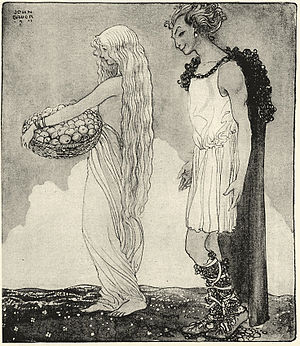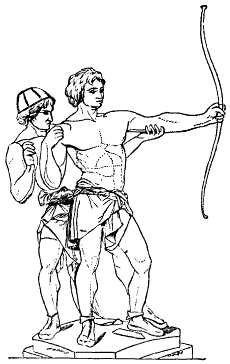Loki: Difference between revisions
No edit summary |
mNo edit summary |
||
| Line 10: | Line 10: | ||
Like Odin (though to a lesser extent), Loki bears many names : ''Lie-Smith, Sly-God, Shape-Changer, Sly-One, Lopt, Sky Traveller, Sky Walker, Wizard Of Lies'' and ''Loftur'' among others. |
Like Odin (though to a lesser extent), Loki bears many names : ''Lie-Smith, Sly-God, Shape-Changer, Sly-One, Lopt, Sky Traveller, Sky Walker, Wizard Of Lies'' and ''Loftur'' among others. |
||
The composer [[Richard Wagner]] presented Loki under an invented [[German language|Germanized]] name '''Loge''' in his opera [[Das Rheingold]]--Loge is also mentioned, but does not appear as a character, in [[Die Walküre]] and [[Götterdämmerung]]. The name comes from the common mistranslation and confusion with Logi (a fire-giant), which has created the misconception of Loki being a creation of fire, having hair of fire or being associated with fire |
The composer [[Richard Wagner]] presented Loki under an invented [[German language|Germanized]] name '''Loge''' in his opera [[Das Rheingold]]--Loge is also mentioned, but does not appear as a character, in [[Die Walküre]] and [[Götterdämmerung]]. The name comes from the common mistranslation and confusion with Logi (a fire-giant), which has created the misconception of Loki being a creation of fire, having hair of fire or being associated with fire. |
||
==Nature== |
==Nature== |
||
Revision as of 23:02, 22 May 2007
It has been suggested that Loki and the dwarfs be merged into this article. (Discuss) Proposed since March 2007. |
Loki or Loke is the mythical being of mischief in Norse mythology, a son of the giants Fárbauti and Laufey. He is described as the "contriver of all fraud". He mixed freely with the gods for a long time, even becoming Odin's blood brother.
Despite much research, "the figure of Loki remains obscure; there is no trace of a cult, and the name does not appear in place-names."[1] Sources inconsistently place him among the Æsir; however, this may only be due to him being a journey man of sneak and his close relation with Odin and the amount of time that he spends among the Æsir.
Like Odin (though to a lesser extent), Loki bears many names : Lie-Smith, Sly-God, Shape-Changer, Sly-One, Lopt, Sky Traveller, Sky Walker, Wizard Of Lies and Loftur among others.
The composer Richard Wagner presented Loki under an invented Germanized name Loge in his opera Das Rheingold--Loge is also mentioned, but does not appear as a character, in Die Walküre and Götterdämmerung. The name comes from the common mistranslation and confusion with Logi (a fire-giant), which has created the misconception of Loki being a creation of fire, having hair of fire or being associated with fire.
Nature
The trickster character is a complex character, a master of guile and deception. Loki was not so much a figure of unmitigated badness as a kind of celestial con man. He would often bail out the gods after playing tricks on them, as illustrated by the myth in which he shears Sif's hair and then replaces it, or when he is responsible for the loss of Iðunn's apples of youth and then retrieves them again. Loki is an adept shape-shifter, with the ability to change both form (examples include transmogrification to a salmon, horse, bird, flea, etc.) and sex.
In some stories, Loki is conceived of as a fire spirit, with all the potential for good and ill associated with fire. However, this view may be due to linguistic confusion with logi "fire", as Loki's primary role is predominantly associated with Odin, typically as Odin's wily counterpart. That said, there is a story in Gylfaginning in Snorra-Edda where Loki competes against a jotunn called Logi in an eating competition, and loses miserably when Logi has not only eaten all the meat, but the bones and the tray as well. Later, it turns out that Logi was in fact not a real jotunn, but wildfire given a lifelike appearance by magic.
Yet another explanation of the name and hence the character, is that the word Loki is related to the old german verb lukijan, connected to the closing of a ring (to lock it). Thus, the word is connected both to the action of "locking" circlets, and hence to "travel by crooked paths", something that might well be an apt description of a trickster god.
Children

Loki was the father (and in more than one instance the mother) of many beasts, humans and monsters.
Having liaisons with giantesses was nothing unusual for gods in Norse mythology—both Odin and Freyr are good examples; and since Loki was actually a giant himself, there is nothing unusual about this activity. Together with Angrboda, he had three children:
- Jörmungandr, the sea serpent;
- Fenrir the giant wolf preordained to slay Odin at the time of Ragnarök;
- Hel, ruler of the realm of the dead.
Loki also married a goddess named Sigyn who bore him two sons: Narfi and Vali. (This Vali is not to be confused with Odin's son with the giantess Rind). To punish Loki for his part in Balder's death the gods turned Vali into a rabid wolf who proceeded to tear Narfi's throat out. Narfi's entrails were used to chain Loki to a large rock until Ragnarok.
While he was in the form of a mare Loki also gave birth to Sleipnir, the eight-legged steed of Odin.
Scheming with fellow gods
Loki occasionally works with the other gods. For example, he tricked the unnamed giant who built the walls around Asgard out of being paid for his work by distracting his horse while disguised as a mare—thereby he became the mother of Odin's eight-legged horse Sleipnir. In another myth, he puts the dwarves against each other in a gifting contest. The dwarves make Odin's spear, Freyr's ship and Sif's wig. He even rescues Iðunn. Finally, in Þrymskviða, Loki manages, with Thor at his side, to retrieve Mjolnir after the giant Þrymr secretly steals it, in order to ask for Freyja as a bride in exchange.
Even though Loki may have been a liability to gods (leading to the death of Balder, the birth of Fenrir and other monsters that would eventually engulf the world), he provided the gods with all their most precious items, from Thor's hammer to the flying ships, and these artifacts help the gods ultimately defeat evil.
Friend to man

Not all lore depicts Loki as a malevolent being. An 18th century ballad (that may have drawn from a much earlier source) from the Faroe Islands, entitled Loka Táttur, depicts Loki as a friend to man: when a thurs (troll or giant) comes to take a farmer's son away, the farmer and his wife pray to Odin to protect him. Odin hides the son in a field of wheat, but the thurs finds him. Odin rescues the son and takes him back to the farmer and his wife, saying that he is done hiding the son. The couple then prays to Hœnir, who hides the son in the neck-feathers of a swan, but again the thurs finds him. On the third day, they pray to Loki, who hides the son amidst the eggs of a flounder. The thurs finds the flounder, but Loki instructs the boy to run into a boathouse. The giant gets his head caught and Loki kills him by chopping off his leg and inserting a stick and a stone in the leg stump to prevent the thurs from regenerating. He takes the boy home, and the farmer and his wife embrace both of them.
Slayer of Balder
Loki may have overplayed his hand when, disguised as a giantess, he arranged the murder of Balder. He used mistletoe, the only plant which had not sworn never to harm Balder, and made a dart of it, which he tricked Balder's blind brother Höðr into throwing at Balder, thereby killing him. Another version of the myth, preserved in Gesta Danorum, does not mention Loki.
It was also possibly he who, in the shape of the giantess Thokk, was the only being that refused to weep for Balder, preventing the defunct god's return from Hel.
The binding of Loki and his fate at Ragnarök
The murder of Balder was not left unpunished, and eventually the gods tracked down Loki, who was hiding in a pool at the base of Franang's Falls in the shape of a salmon. There they caught the Trickster with his own famous invention, the fishing net. They also hunted down Loki's two children with Sigyn, Narfi and Váli (not to be confused with Váli, the son of Odin and Rind). They changed Váli into a wolf, and he then turned against his brother and killed him. They used Narfi's entrails to bind Loki to three slabs of stone, and Skaði placed a snake above his head so that its venom would pour onto him. Sigyn sits beside him and collects the venom in a wooden bowl, but she has to empty the bowl when it fills up, during which time the searing venom drips onto the Trickster's face. The pain is then so terrible that he writhes, making the earth shake.
Balder's murder was also one of the events that precipitated Ragnarök. Loki would stay bound until then. When Ragnarök finally comes and Loki is freed by the trembling earth, he will sail to Vigrid from the north on a ship that also bears Hel and all those from her realm. Once on the battlefield, he will meet Heimdall, And though Loki is victorious, he later dies of the wounds in battle.
Homologues
Loki can be compared to Coyote, Raven, and Kokopelli, who are all trickster figures of Native American mythology. Others compare him to Hermes, who tricked Apollo and also often broke boundaries. He had also been compared to Prometheus, who tricked and stole from the gods, and was also bound to a rock and tormented by an animal (in his case an eagle) as punishment. During the Viking era, some considered him as corresponding to the god of chaos Saturn/Cronus, and called him Saeter.[2]. In Polynesian mythology, his most similar parallel is the trickster demigod Māui (mythology). Regarding the Aztec mythology, his counterpart would be Huehuecoyotl. In West Africa, he is most similar to Eshu.
Loki in modern references
Portrayals of Loki in modern culture vary wildly, from villainous and malicious trickster to benevolent yet mischievous hero.
See also
Other spellings
- Common Danish, Swedish and Norwegian form: Loke
- German form: Lohho, Loge (Wagner)
References
External links
- Viktor Rydberg's "Teutonic Mythology: Gods and Goddesses of the Northland" e-book
- W. Wagner's "Asgard and the Home of the Gods" e-book
- "Myths of Northern Lands" e-book by H.A. Guerber
- Peter Andreas Munch's "Norse Mythology: Legends of Gods and Heroes" e-book
- An essay on Loki
- More images of Loki
- The Lokasenna - "Loki's Wrangling": an insult competition between Loki and the other gods
see also the film "Son of the Mask" for Loki's attributes.
